According to a 2019 Common Sense Media survey, more than half of teens reported using Instagram, Twitter, or YouTube to get their news. 20% of those teens also reported that getting news from social media made them more confused about current events. Oh, and they prefer to view images or videos instead of print or audio sources.
We know today’s students are active consumers of media. But sometimes teachers feel overwhelmed by the thought of tackling how to teach new skills that keep developing in the fields of media and news literacy. So, let’s get back to the new basics!
Media Literacy Resources
The National Association for Media Literacy Education (NAMLE) provides clear definitions of the term media literacy:
- “Media refers to all electronic or digital means and print or artistic visuals used to transmit messages.”
- “Literacy is the ability to encode and decode symbols and to synthesize and analyze messages.”
An effective place to start with media literacy instruction is to follow NAMLE’s document “Key Questions to Ask When Analyzing Media Messages.”
News Literacy Resources
The News Literacy Project recently released a Framework for Teaching News Literacy, including five standards, suggested activities, guiding questions, and more. It will be easy for classroom teachers and librarians to embed these five standards into other content areas so that learning takes place within a context instead of being viewed as a “stand-alone” skill. Also note that NLP’s online learning platform, Checkology, offers many engaging, interactive learning resources to help you teach these five standards.
Standard 1: Students distinguish news from other types of information and can recognize both traditional and nontraditional ads.
Standard 2: Students acknowledge the importance of the First Amendment in American democracy and a free press to an informed public.
Standard 3: Students understand the standards of quality journalism and can use them to identify credible information and sources.
Standard 4: Students demonstrate increased critical habits of mind, including effective verification skills and the ability to detect misinformation and faulty evidence.
Standard 5: Students express a sense of responsibility for the information they share and feel more empowered to be civically engaged.
Implementing Media and News Literacy
When designing learning opportunities, keep in mind these key concepts from “Cognitive and Social Frameworks for Teaching and Learning” published in Information Literacy and Information Skills Instruction: New Directions for School Libraries:
- Learning a skill within a context is far superior than teaching it as a “stand-alone” skill
- Allowing students to develop a personal perspective on a topic allows for deeper learning
- Create opportunities to implement inquiry-based learning principles such as students brainstorming research questions and completing hands-on tasks
Lesson Plan
When the Mark Zuckerberg story broke in the fall of 2021 about Instagram’s effects on young users and his testimony in front of Congress, I knew my journalism students would be interested in learning more. I created a Google Hyperdoc lesson that incorporated media and news literacy instruction to explore the following guiding question: Who should control/regulate the Internet?
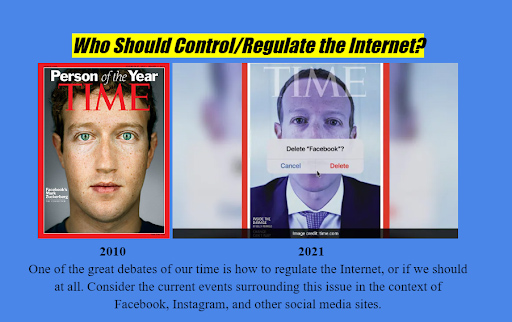
We began this activity by analyzing two images of Mark Zuckerberg from the cover of TIME magazine. We asked students to analyze colors, use of words and other images, the tone that the visual elements establish, and the overall purpose of each cover. I challenged students to find other published images of Zuckerberg to contrast to those we previously analyzed.
After reading several articles about the developing events, we brainstormed various stakeholders in this issue, discussing their values and how those might shape their opinions. This exercise helps students think about the issue from various viewpoints. Here is a snapshot of part of the shared Google Doc we developed.
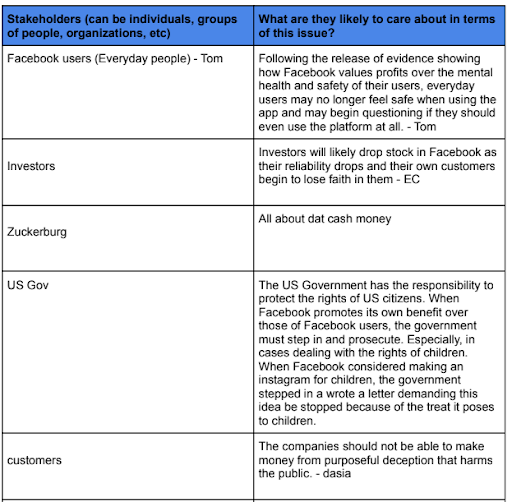
Students spent the next several class periods reading straight, unbiased news articles about the problem. Then I asked them to find examples of other straight, unbiased news articles on the same topic, along with examples of commentary or opinion pieces. We kept a chart on a shared Google Doc, and I included a reflection column.
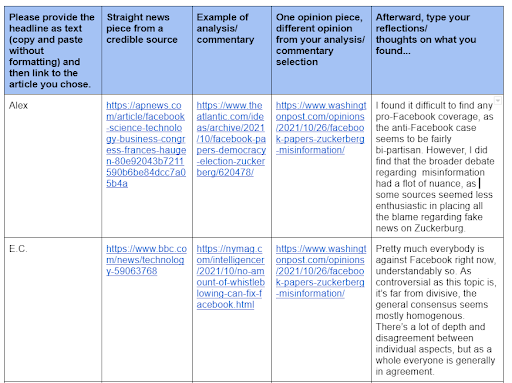
This chart is an effective teaching strategy because there can certainly be more than one potential answer for each column, and the teacher can see if students are selecting articles which fit the criteria for each column, providing remediation when necessary. Additionally, students can discover new sources of credible news by sharing their work in this way.
I also asked students to find their own examples of user-generated content and/or memes to share on this topic or related topics. We compiled their work using a similar chart on a shared Google Doc. Students can study how information creators utilize elements of media creation to convey a message as well as what the motivation is behind the message, and they should also utilize lateral reading skills to fact-check claims.
When teaching students to approach media and news with critical thinking, many organizations have created helpful infographics explaining useful habits and behaviors. Consider this one from Mike Caulfield, and read his eBook Web Literacy for Student Fact Checkers.
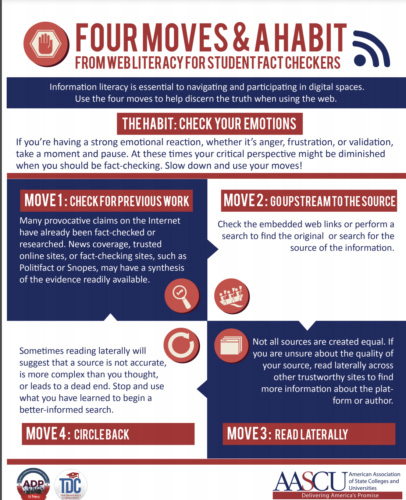
Also helpful is this infographic from the News Literacy Project. Have students create their own infographics for these skills after doing some practice so they can decide what’s important when analyzing media and news.
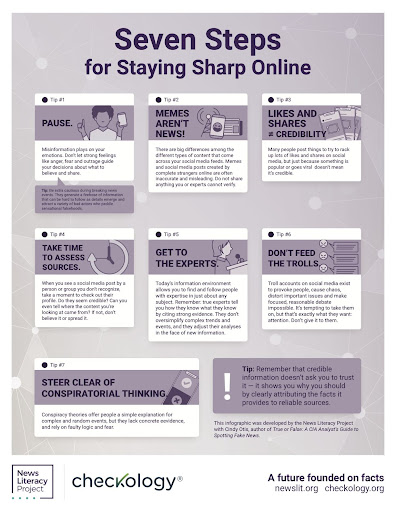
Censorship
Unfortunately, much of what is well-established practice in the field of education is coming under fire from censors, including elements of media and news literacy. Even using those terms causes some people to assume that we mean “news media” and that we are indoctrinating students into utilizing only certain “biased” news sources. Those misplaced fears could not be further from the truth.
As you can see in my instructional examples, I do not tell students which opinions they should believe or adopt as their own. Rather, I design learning experiences for students to explore a wide variety of viewpoints as well as why people have those viewpoints. To accomplish this, they need to access a wide variety of information sources.
The National School Library Standards (2018) state that learners should be aware of what they don’t know. Furthermore, “Not everything a learner hears will be accurate or beneficial, so honing critical and analytical skills is crucial to growth as an informed global citizen” (78). Our students are growing up in a world of media, and they will be adults in a world of media. Thus, educational instruction must address these critical needs.
References Cited
American Association of School Librarians. (2018). National School Library Standards for Learners, School Librarians, and School Libraries. ALA Editions.
Thomas, Nancy Pickering, et al, Eds. (2020). “Cognitive and Social Frameworks for Teaching and Learning.” Information Literacy and Information Skills Instruction: New Directions for School Libraries. 4th Ed. Libraries Unlimited.
See also:



